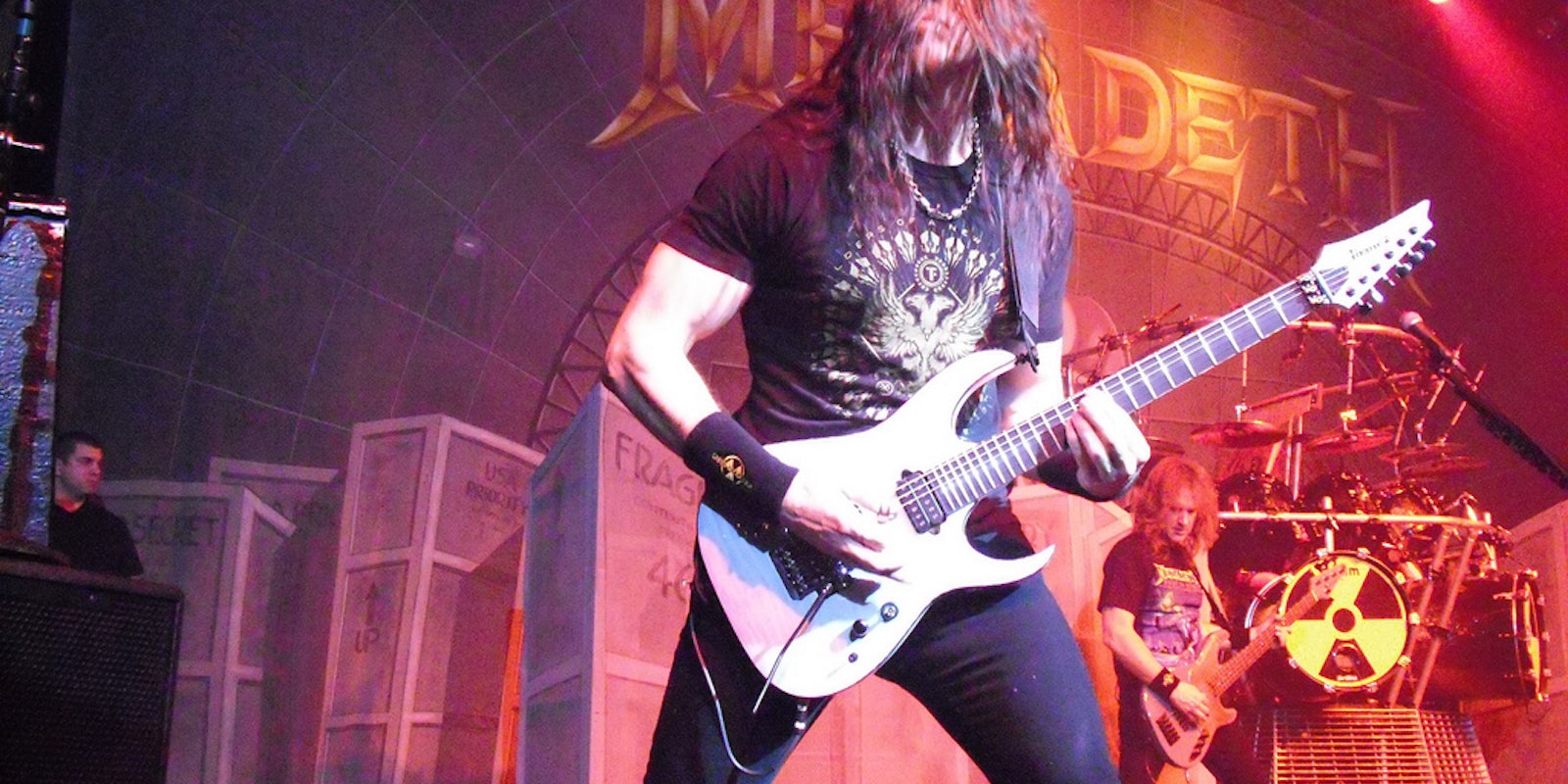“The music industry’s first runaway hit on the Web”? — ?Interactive Age
This is the story of how an unlikely threesome—a girl, a heavy metal band and their fans?—pioneered the Web at its infancy, bucked the status quo and proved that the Internet wasn’t a fad.
It’s 1994. I’m working at Capitol Records in Hollywood, California. Pulp Fiction was about to hit the box office and infiltrate pop culture with its timeless lines, some the music industry should have noted:
“Look, do you wanna play blind man? Go walk with the shepherd. But me, my eyes are wide fucking open.” — Jules Winnfield
The #1 song was “The Sign” by Ace of Base. They saw the sign and it opened up their eyes. Prince wouldn’t be partying for another 5 years.
And for the record business—?well, they didn’t have anything to complain about. They printed money selling shiny plastic discs and virtually controlled everything from record stores to radio stations. Their marketing strategy of million dollar print, radio and TV campaigns was tried and true and as the saying goes, “If it ain’t broke, don’t fix it.” It was the golden era of the music business and the good ‘ole boys, they liked to throw parties. I should know, I went to them.
So, during this “diamonds on the soles of their shoes” era, there was no vision for the future. They didn’t think they needed one.
As for me, I had moved from Texas to Hollywood to pursue a glamorous career in rock and roll, but things were going a lot slower than planned. After years of paying my dues as an assistant, I knew I needed to do something bold or I would be making photocopies and answering the phones for the rest of my career. This was the year that was finally gonna bring on the magic.
What happened next was about to change music history.
This chain of events started with a word that was soon to be all the rage: Multimedia—a new way to combine music, video, graphics and interactivity using a computer.
The moment I realized that multimedia could revolutionize the way we could market our music came when a co-worker named Dave Goldberg showed me the first music video made with Macromedia Director—an interactive multimedia authoring tool. When I saw that video, I knew I had to hunt down the programmer. His name was Doug Textor, and he agreed to meet me for breakfast. I told him that I had all these ideas for using the computer to promote our bands but I didn’t know if it was technically possible yet. He said it was, although I don’t think he knew exactly what it entailed, but neither did anyone else at the time.
Our harebrained concepts were put to the test when I was tasked with marketing the upcoming album releases for Frank Sinatra and Bonnie Raitt. Using Director, we created these hilarious-yet-primitive video games that my boss presented to the sales team while I operated the computer. Despite a few head scratches, the game broke new ground and we actually won an award.
We knew we were onto something.
After these multimedia presentations, I wanted to try some more experiments, as there was a blank canvas to innovate. Two online services, Prodigy and CompuServe, were quickly becoming popular, and so were screensavers. We created one for the Beastie Boys and uploaded it into the software and gaming forums to see what would happen. We also put the screensavers on floppy disks with a whopping 1.5 meg of disk space, not even room for a single song.
As the screensaver was getting momentum, I was about to get introduced to the Internet, thanks to a cousin I barely knew living in Silicon Valley. He was referred to in our family as a cocky computer genius who loved his Steve Jobs. One night we met up in San Francisco where he took me to his office, which was a startup before I even knew what startups were. He showed off his NeXT computer.
Then he showed me this thing called the World Wide Web.
And I knew: Holy shit. This is it.
The Hollywood Handshake
When I returned to Hollywood, I had to explore this spectacle further, but actually getting on the World Wide Web was a technical bitch. If you understood computers back then, you were described as “computer-literate.” But it was even difficult for us “literates” to understand the new world of TCP/IP, PPP, Gopher and Telnet. Since I had real job responsibilities during the day, I would spend my nights alone in the Capitol Tower, just trying to get that damn computer to dial up a modem, in hopes of being rewarded with that glorious sound of the modem connecting. Back then, we tech geeks called it “the handshake.”
I failed, but was still determined.
One day, I got a memo in “interoffice mail.” I was invited to be on a task force for the upcoming Megadeth album Youthanasia and I was to attend the first brainstorming meeting.
Me? Megadeth?
Here’s what I knew about Megadeth: The lead singer, Dave Mustaine, was kicked out of Metallica, and then Megadeth went on to become the most respected heavy metal band of their time, second to Metallica.
During the meeting, the executives stressed the importance of this album release, so it seemed like the perfect opportunity to do something big and bold on the World Wide Web. Having never heard of the Internet, the record executives were like “yeah, whatever kid” and defaulted to the usual checklist: “Who will shoot the album cover? How many radio stations will play the single? How many posters should we print for the record stores?”
So even though no one had a clue what I was talking about, I wrote a proposal to create a “virtual cybertown in cyberspace.” It would be called Megadeth, Arizona—based on where the band lived and recorded their album.
My boss, Lou Mann, the Senior Vice President of the label, actually signed off on the proposal and gave me a whopping $30 grand.
He had no idea what it was for, and I can guarantee you, neither did I.
In the proposal, I describe the Internet as consisting of “intelligent, upwardly mobile people” amongst other verbal atrocities. The proposal went on for two pages, where I also explained “while other bands are stuffing envelopes, mailing labels and licking stamps, we’ll send electronic messages, tour dates and updates.” Oh, man.
Now that I was funded, I corralled two of my co-workers to help create the site—Wendy Dougan, who was designing CD album packages in the art department, and Jane Bogart, the company copywriter for those full page ads that bands used to put in magazines.
They did not know what the Internet was either.
Wendy found a book on Roadside America that set the creative direction. We found a 1940’s postcard at a flea market that read “Greetings from Arizona.” Jane came up with a tag line: Megadeth, Arizona: You’ve never been anywhere like it.
Yahoo’s homepage—originally called Jerry and David’s Guide to the World Wide Web.
There were three main design options for the Web at the time:
1) Grey backgrounds
2) Times Roman type
3) Graphics were buttons
For content, we assumed a band website would offer the basics like news, music and video.
MEGABYTE NEWS—?band news
K-DETH 101?—:30 second music clips
THE DIGITAL DRIVE IN—slow moving video clips
Like any town, we thought it should spread gossip, deliver the mail and conduct town meetings, so we created a few “Internet firsts” like:
A CHATROOM—The Megadiner was the first chatroom for a band. Fans could chat with each other 24–7 and the band would frequently join in, unannounced.
A DIGITAL POSTCARD—This was one of the first applications where one could send a graphic via email, which programmers told us was technically impossible. We took the Megadeth, Arizona postcard and added a form where you could type in a friend’s email address (if they had one, that is) and add a custom message: “Hey Bob! Greetings from Megadeth, Arizona. Wish you were here!” The idea for the digital postcard was inspired by a job I had selling greeting cards. (Who knew that job would come in handy?)
To promote the website, we made postcards and stickers, because that’s how traditional marketing was done ?—? using people to pass out pieces of paper.
Right before the site launched, I started to panic. Is this any good? Is the band going to hate it? Will heavy metal fans revolt?
But at the same time, we didn’t think any of that mattered, because we didn’t think anyone would even see it.
Then we went live.
Even though I was sure about the Web’s potential, I couldn’t even begin to predict what was about to happen. It was the people who came to the site and populated it that made the technology come alive.
After that, everything took a life of its own.
When the site hit the mainstream, it got the attention of Starbucks. Company CEO Howard Shultz and his executive team asked to meet with Capitol Records to see what they could learn, so that they too could have a website. I presented a screensaver called The Flying Roasters, which paid homage to the most popular screensaver at the time—The Flying Toasters. We took Starbucks coffee bags, added wings and had them fly across the home screen to the song “Cantaloop” by US3. During the presentation, Howard, who clearly had visions of the future dancin’ in his head, grabbed my arm and nearly pulled me onto the floor. He grabbed all of the screensavers off the conference room table and tried to squeeze them into his top shirt pocket.
It took outside validation from Starbucks for the Capitol executives to see that our own company was leading the way.
By the time Howard had touched down in Seattle, my salary had doubled.
‘Til Deth Do We (Didn’t) Part
At the height of Megadeth, Arizona’s popularity, Capitol wanted to close down the site because the band’s album cycle was ending — still living in a world of limited promotional flights and expiring campaigns. Can you imagine shutting down a popular site today?

Things We Never Could Have Predicted About Megadeth, Arizona
1) The site drove interest in computers.
We got emails from people telling us that the site inspired them to buy computers, modems or get Internet connections.

2) The site helped put the Internet on the mainstream media’s radar.
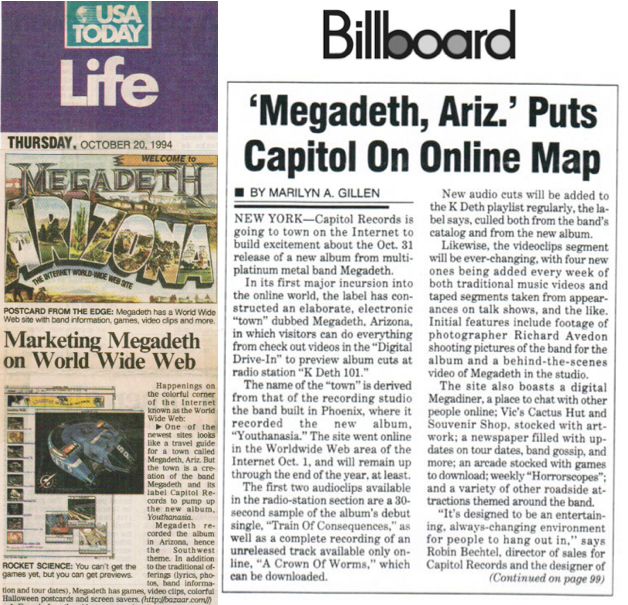
3) Megadeth, Arizona opened the door for bands to market on the Internet.
“This groundbreaking site set the tone for artist sites to come.” ?— ?Music Connection
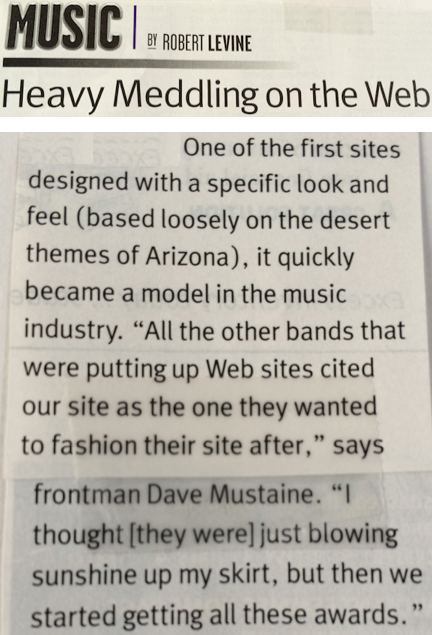
4) This Internet thing — it’s global!

5) This would be the birth of social media.
“One of the first online communities” — ?L.A. Times
“One of the first Webchats” — ?Wired
The site gave the fans the ability to talk to each other, meet one another in person and bond all based on a common interest? — ?their favorite band. Some dated and got married. A woman complained she got “the clap” from another fan after they advanced their relationship from the Web to the real world. Whoops, sorry. We’re not liable!

6) Unprecedented access to celebrities
“Dave Mustaine used the Web to reach out to his fans—but that brought its own complications. When he first ventured into his site’s chatroom, none of the fans believed he was who he said he was. Once they realized it was him, they wouldn’t leave him alone.” — Rolling Stone
Back then, the rock star was bigger than life—distant and inaccessible. The site allowed the band to interact with a large number of fans at once—raw, intimate and unfiltered. For the fans, being able to chat with the band seemed so unbelievable at first that they would put them through a verification process.
Here’s a Megadiner chatroom transcript, where fans grilli Dave Mustaine in the chatroom to verify his identity.
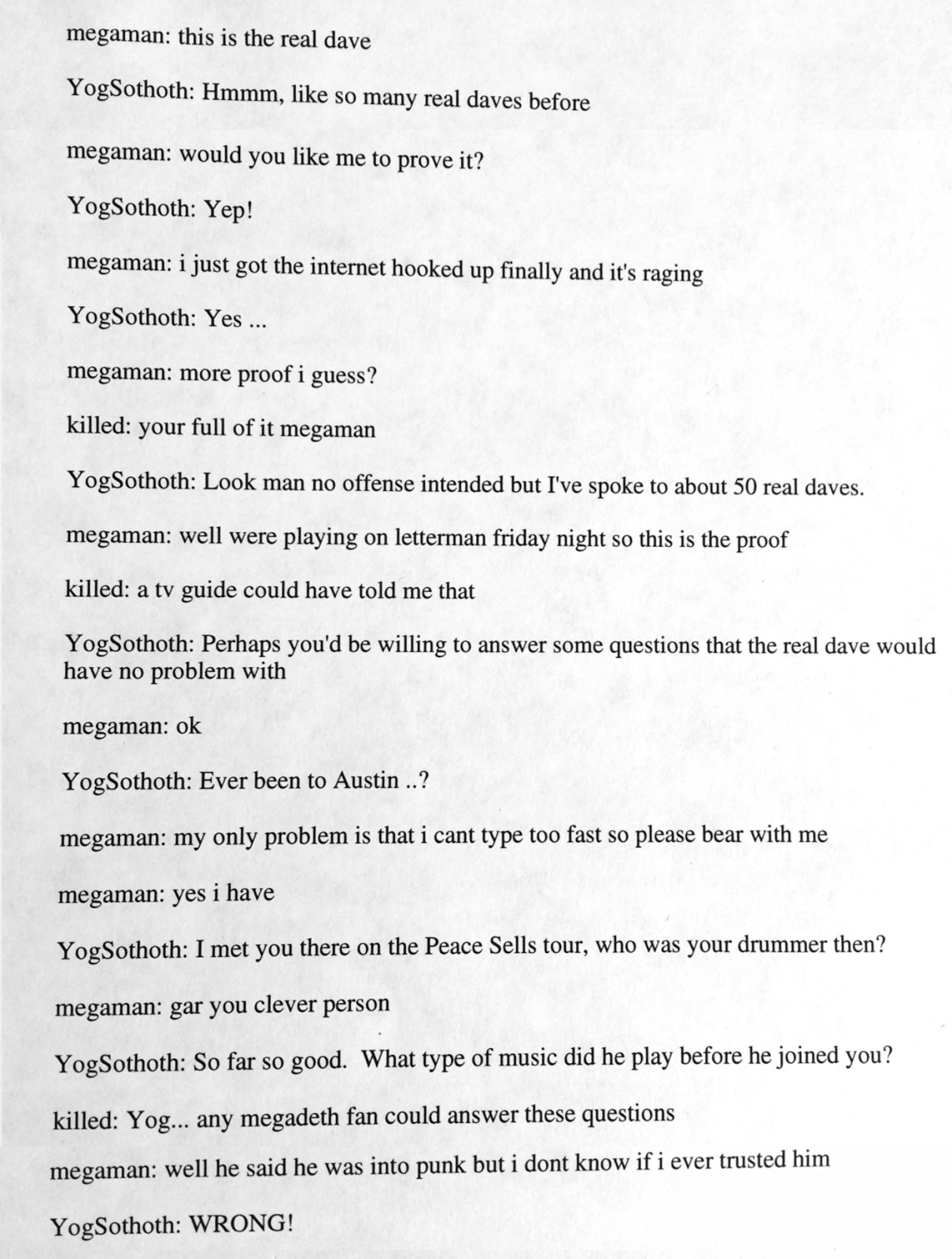
The band also rallied their fans to help with various missions, motivating them with a digital name?—?The CyberArmy. These are all early examples of how social media is used today.
7) The beginning of “going viral”
I didn’t realize while creating the digital postcard that when people would send one to a friend, ?their friend would also learn about the website. You could create one digital master of a concept, and people could spread the word for you — as if it was their idea. Goodbye print marketing, hello digital.
8) The band were pioneers, too.
“It’s the Wild, Wild West but we think we should go for it.” — Megadeth
The band embraced the website immediately and jumped right in. They were already into computers, so they were able to speak articulately about the Web, which they viewed as a “modern version of tape trading.”
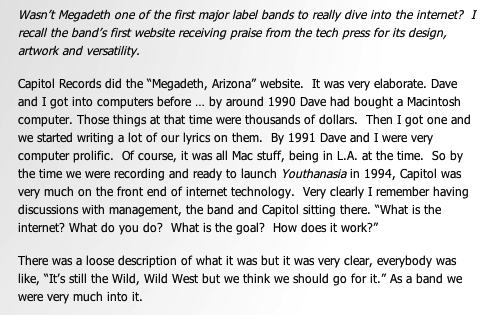
“What is the Internet? What do you do? What is the goal? How does it work?” ?— ?Megadeth
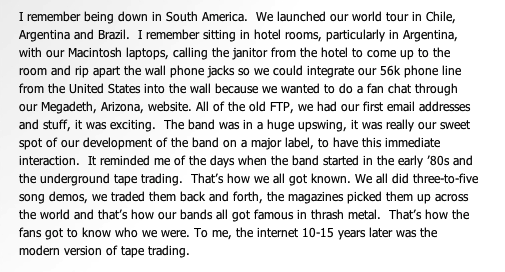
My proudest memory of Megadeth, Arizona, was that the early site adopters, the band and the fans, myself and my Web team and the early journalists—together, we made people believe that the Internet was here to stay.
And it did.
If you are reading this story twenty years later and you were one of the early adopters of our town, we have frequently wondered if you’re still out there floating in cyberspace—albeit at a faster speed.
In 1994, no one could have predicted all the ways that we’d be using technology today. So imagine what you can create in the next 20 years.
Just start somewhere. Believe and make others believe!
“You see, this profession is filled to the brim with unrealistic motherfuckers. Motherfuckers who thought their ass would age like wine.” — Marsellus Wallace
Thank you to my incredible friends who contributed to this story: Shon Tomlin, Lou Mann, Dave Goldberg, Jason Trawick, Jon Sulkow, Ashley Nichols, Mio Shibata, and Dan Nainan.
This piece originally appeared on Medium, and was reprinted with permission.
Photo via Ted Van Pelt/Flickr (CC BY 2.0)

